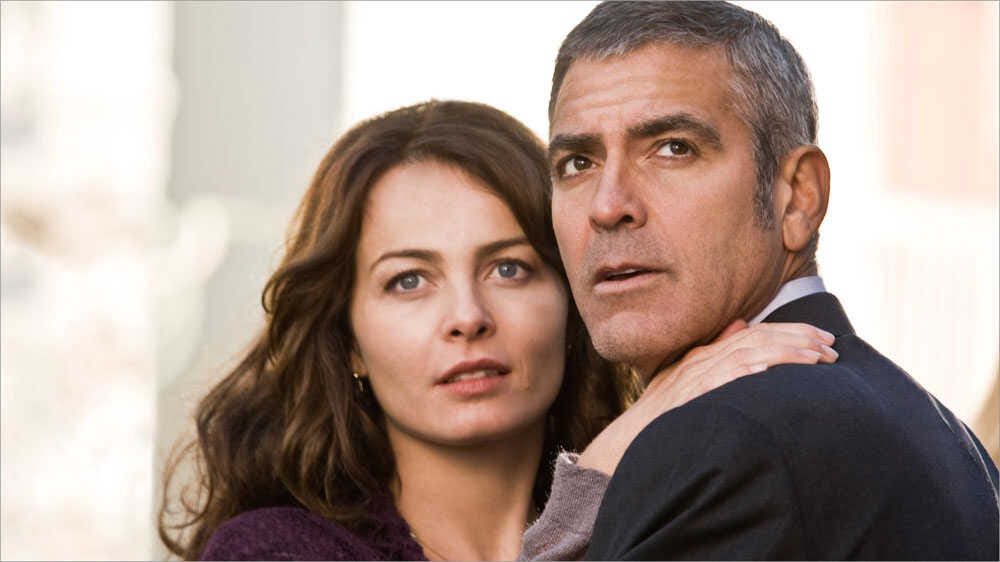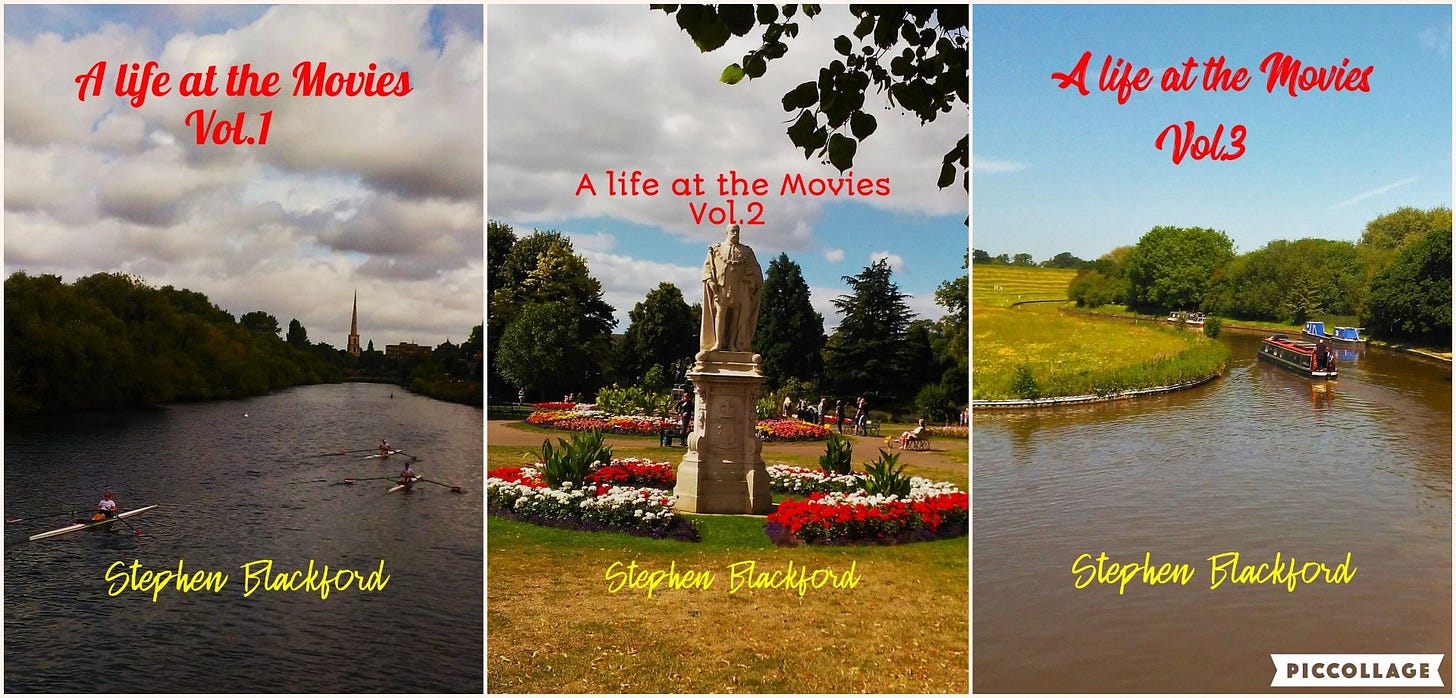The American (2010) Still a slow burning joy from Anton Corbijn
“I don’t think God is very interested in me, Father”

I’ve adored The American, Anton Corbijn’s second all time feature length film from the director’s chair, since I purchased the DVD almost immediately on release back in a long ago 2010. Hopefully the dissection of the opening 13 minutes that follows will whet your appetite for a beauty of a film before I extol the virtues of the film still further in my concluding paragraph.
But first, the opening 13 minutes:
Following simple and silent white on black opening production credits we dissolve into the snowbound idyll of Dalarna, Sweden, before a slow camera zoom (and the beginnings of Herbert Grönemeyer’s wonderful if rather mournful piano soundtrack) finds a remote cabin in the snow and two lights illuminating the way as we dissolve inside to find two lovers in each other’s arms in front of a roaring log fire, drinking whiskey. Cutting to the following day, we now see our two lovers “Jack” (George Clooney) and “Ingrid” (Irina Björklund) leaving the cabin for a morning walk in the deep snow, arm-in-arm, and with the first close-up of their morning walk comes the first dialogue of the movie and Ingrid suggesting she’ll head into town later and asking if Jack needs anything. With a beaming smile that screams that he has everything he needs right here beside him, he says no. Following a change of camera angle to a wider shot of the couple, their hideaway couldn’t be any more snowbound or remote, however on returning to close-up shots of the two lovers Jack spots a singular set of footprints in the snow and after Ingrid suggests they may belong to a hunter, Jack scans the nearby hills before dragging Ingrid with him and behind a rock wall as a bullet ricochets a few inches from them. Coming under further fire as he tries to scan the nearby hill above him, Jack pulls a gun from his trousers as Ingrid exclaims “You have a gun? Why would you have a gun?” before Jack shushes her, edges his way along the rock wall, before expertly killing the assassin above him with two deadly shots. With the dead body falling to the snow below and at his feet, Jack quickly searches the body for any identifying evidence before ordering Ingrid to return to the cabin and call the police. As she makes her way toward the cabin and with her back to Jack, he shoots her in the back of the head.
The above scene ends with a slightly panicked and heavy breathing Jack unable to comprehend how he’s been tracked to this remote spot in the middle of nowhere and the ending of an innocent life as we cut to a second assassin loading and checking his gun in a car nearby. Exiting the car, the assassin walks slowly in front of the parked car before stopping and standing, scanning the area around him silently and for some time, the camera never wavering from him. Until with a jerked motion the assassin turns around to be met with a running and firing Jack who kills him instantly before checking the dead body for any identifying evidence, to Jack driving away from his snowbound retreat, to boarding a yellow car ferry as he looks wistfully into the distance, to the squeal of brakes as he arrives in Rome by train from Munich. Departing the train in sunglasses and carrying two large bags, Jack immediately makes for a payphone and after confirming to his caller that he’s in Rome, there’s an audible sigh in response from the man on the other end of the call and an instruction to wait for him at a nearby bar before he hangs up.
We cut to Jack peering out of the window seats inside the local bar and as we now dissolve inside the bar the time is roughly 10.40am and Jack, shot in close-up, tired and exhausted, his head in his hands, and now 11.10am and the final arrival of his telephone contact “Pavel” (Johan Leysen). From a simple one camera shot of both men (with a window onto a busy Rome behind them) and clearly not overly pleased to see the other, we now cut to single shots of each man as Pavel asks somewhat sarcastically who was the girl in Sweden to which Jack immediately responds with a far more urgent question as to who were the assassins and how had they tracked him? “I’m working on that” replies a stone-faced Pavel and “It’s going to take time” before he accuses Ingrid of setting Jack up, an accusation Jack quickly and coldly dismisses out of hand. Clearly the best of enemies, their frosty interaction continues until Pavel passes Jack a car key and directions to the Italian hills to “lay low”, “don’t talk to anyone” and “above all, don’t make any friends, Jack. You used to know that”. Jack never takes his eyes away from Pavel as he immediately leaves the bar.
We cut to a long yellow coloured tunnel with Jack driving and shot in a shadowy silhouette as the opening credits continue accompanied by the film’s distinctive piano led theme tune. As he drives ever closer to a heavenly white light at the end of the tunnel the screen turns white with “THE AMERICAN” in black font as Jack quickly arrives in Castelvecchio as per Pavel’s instructions. Stepping out of his car in this eerily quiet hillside town he’s met with several dead eyed stares from the local inhabitants and quickly retracing his steps and turning the car around, he finds a nearby road sign for the town of Castel del Monte and after a close-up on a map and a mobile telephone sealed inside a plastic bag on the passenger seat, Jack winds down the car window and tosses the phone into the river below as he speeds away.
Fade to Black.
Based on the 1990 novel A Very Private Gentleman by Martin Booth, there are homages galore to films and styles of films from the past and in large part both to Spaghetti Westerns and to films and genres outside of my cinema experience. But the film I immediately drew parallels with is the more contemporary Michael Clayton (directed by Tony Gilroy) with George Clooney once more in a cold, dead to the world persona of watching and observing the world around him and whilst wanting to stay in the shadows is instead drawn into the light of life via his interactions with the local priest (Paulo Bonacelli is excellent as “Father Benedetto) and a local prostitute (the purest sunshine of the film from Violante Placido as “Clara”). Here the shadow and the light of Jack’s life is writ large in two ongoing human interactions that pepper and define this wonderful film as whether Jack is lamenting coldly to the local priest that he doesn’t feel “God is very interested in me” or in the rays of the sun provided by Clara, the somewhat duality of light and shade, shadow and perhaps even the shadow self is portrayed still further in his dual interactions with Pavel or prospective buyer “Mathilde” (Thekla Reuten). For Jack (or is it Edward?) is a craftsman of hand-made guns and far from a man who’s “no good with machines”. Modern day machines perhaps and even the mechanics of human discourse and interaction, but Jack is a master craftsman and high in demand even if he wishes this wasn’t so.
The crux of my love for The American resides in my flight of fancy of wishing to live in the Italian hills and the winding streets so brilliantly depicted here by director Anton Corbijn and his cinematographer Martin Ruhe. Accompanied beautifully by Herbert Grönemeyer’s musical score the film is goddamn gorgeous in every frame, deliberately slow paced, reflective, existential, meditative even, and still a slow burning joy of a film all these years later.
Treat yourself sometime.
Thanks for reading. I hope this message in a bottle in The Matrix finds you well, prospering, and the right way up in an upside down world.
Whilst you’re here I may as well brag about the release of my trilogy of recently self-published books. Beautiful covers eh! As the title(s) would suggest, this is my life at the movies or at least from 1980 to 2024, and in volume 1 you’ll find 80 spoiler free appraisals of movies from debut filmmakers, 91 of the very best films appraised with love and absent of spoilers from 1990–2024 in volume 2, and in volume 3 you’ll find career “specials” on Paul Thomas Anderson and Quentin Tarantino together with the very best of the rest and another 87 spoiler free film reviews from 2001–2024.
All available in hardback and paperback and here are some handy links:
"A Life at the Movies Vol.1" - link to Amazon
"A Life at the Movies Vol.2" - link to Amazon
"A Life at the Movies Vol.3" - link to Amazon





